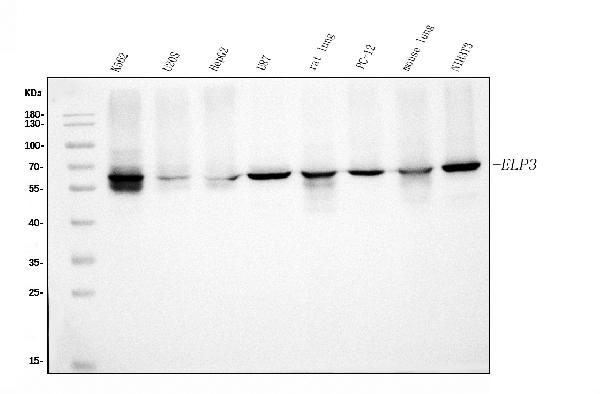Anti-KAT9/ELP3 Antibody Picoband™ (monoclonal, 8B4)
- SPECIFICATION
- CITATIONS
- PROTOCOLS
- BACKGROUND

Application
| WB |
|---|---|
| Primary Accession | Q9H9T3 |
| Host | Mouse |
| Isotype | Mouse IgG2a |
| Reactivity | Rat, Human, Mouse |
| Clonality | Monoclonal |
| Format | Lyophilized |
| Description | Anti-KAT9/ELP3 Antibody Picoband™ (monoclonal, 8B4) . Tested in WB applications. This antibody reacts with Human, Mouse, Rat. |
| Reconstitution | Add 0.2ml of distilled water will yield a concentration of 500ug/ml. |
| Gene ID | 55140 |
|---|---|
| Other Names | Elongator complex protein 3, hELP3, 2.3.1.311, ELP3 {ECO:0000303|PubMed:15902492, ECO:0000312|HGNC:HGNC:20696} |
| Calculated MW | 62 kDa |
| Application Details | Western blot, 0.1-0.25 µg/ml, Human, Mouse, Rat |
| Contents | Each vial contains 4mg Trehalose, 0.9mg NaCl and 0.2mg Na2HPO4. |
| Clone Names | Clone: 8B4 |
| Immunogen | A synthetic peptide corresponding to a sequence at the C-terminus of human KAT9/ELP3, identical to the related mouse sequence. |
| Purification | Immunogen affinity purified. |
| Storage | Store at -20˚C for one year from date of receipt. After reconstitution, at 4˚C for one month. It can also be aliquotted and stored frozen at -20˚C for six months. Avoid repeated freeze-thaw cycles. |
| Name | ELP3 {ECO:0000303|PubMed:15902492, ECO:0000312|HGNC:HGNC:20696} |
|---|---|
| Function | Catalytic tRNA acetyltransferase subunit of the elongator complex which is required for multiple tRNA modifications, including mcm5U (5-methoxycarbonylmethyl uridine), mcm5s2U (5- methoxycarbonylmethyl-2-thiouridine), and ncm5U (5-carbamoylmethyl uridine) (PubMed:29415125). In the elongator complex, acts as a tRNA uridine(34) acetyltransferase by mediating formation of carboxymethyluridine in the wobble base at position 34 in tRNAs (By similarity). May also act as a protein lysine acetyltransferase by mediating acetylation of target proteins; such activity is however unclear in vivo and recent evidences suggest that ELP3 primarily acts as a tRNA acetyltransferase (PubMed:29415125). Involved in neurogenesis: regulates the migration and branching of projection neurons in the developing cerebral cortex, through a process depending on alpha-tubulin acetylation (PubMed:19185337). Required for acetylation of GJA1 in the developing cerebral cortex (By similarity). |
| Cellular Location | Cytoplasm. Nucleus [Isoform 2]: Cytoplasm. Nucleus |
| Tissue Location | Expressed in the cerebellum and spinal motor neurons. |

Thousands of laboratories across the world have published research that depended on the performance of antibodies from Abcepta to advance their research. Check out links to articles that cite our products in major peer-reviewed journals, organized by research category.
info@abcepta.com, and receive a free "I Love Antibodies" mug.
Provided below are standard protocols that you may find useful for product applications.
Background
Elongator complex protein 3, also named KAT9, is aproteinthat in humans is encoded by theELP3gene. It is mapped to 8p21.1. ELP3 is the catalytichistone acetyltransferasesubunit of theRNA polymeraseII elongator complex, which is a component of the RNA polymerase II (Pol II)holoenzymeand is involved in transcriptional elongation. ELP3 supports the migration and branching ofprojection neuronsthroughacetylationof alpha-tubulin in the developingcerebral cortex. In mammals, ELP3 is important for paternalDNA demethylationafterfertilization.ELP3 is potentially involved in cellular redoxhomeostasisby mediating the acetylation ofglucose-6-phosphate dehydrogenase. Besides, ELP3 may play a role inchromatin remodelingand is involved in acetylation ofhistones H3and probablyH4.
If you have used an Abcepta product and would like to share how it has performed, please click on the "Submit Review" button and provide the requested information. Our staff will examine and post your review and contact you if needed.
If you have any additional inquiries please email technical services at tech@abcepta.com.













 Foundational characteristics of cancer include proliferation, angiogenesis, migration, evasion of apoptosis, and cellular immortality. Find key markers for these cellular processes and antibodies to detect them.
Foundational characteristics of cancer include proliferation, angiogenesis, migration, evasion of apoptosis, and cellular immortality. Find key markers for these cellular processes and antibodies to detect them. The SUMOplot™ Analysis Program predicts and scores sumoylation sites in your protein. SUMOylation is a post-translational modification involved in various cellular processes, such as nuclear-cytosolic transport, transcriptional regulation, apoptosis, protein stability, response to stress, and progression through the cell cycle.
The SUMOplot™ Analysis Program predicts and scores sumoylation sites in your protein. SUMOylation is a post-translational modification involved in various cellular processes, such as nuclear-cytosolic transport, transcriptional regulation, apoptosis, protein stability, response to stress, and progression through the cell cycle. The Autophagy Receptor Motif Plotter predicts and scores autophagy receptor binding sites in your protein. Identifying proteins connected to this pathway is critical to understanding the role of autophagy in physiological as well as pathological processes such as development, differentiation, neurodegenerative diseases, stress, infection, and cancer.
The Autophagy Receptor Motif Plotter predicts and scores autophagy receptor binding sites in your protein. Identifying proteins connected to this pathway is critical to understanding the role of autophagy in physiological as well as pathological processes such as development, differentiation, neurodegenerative diseases, stress, infection, and cancer.


